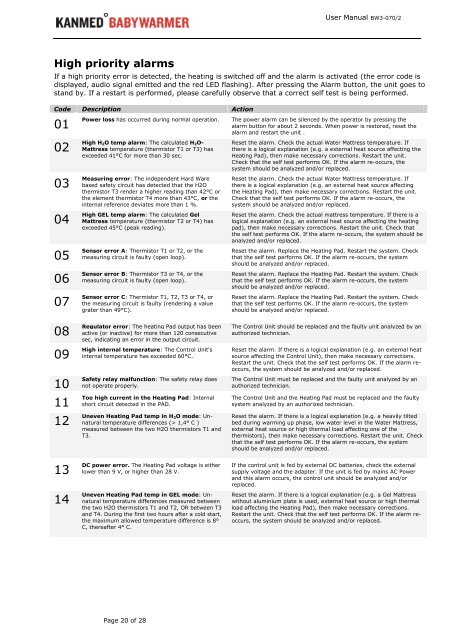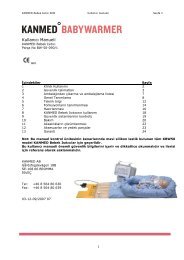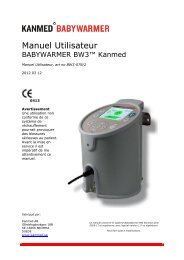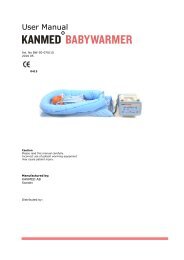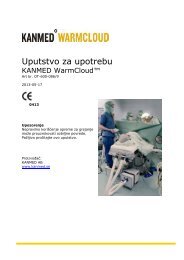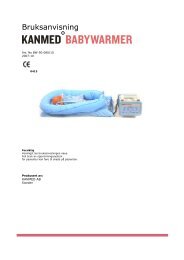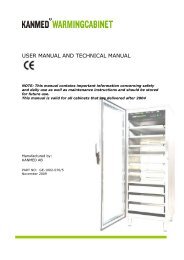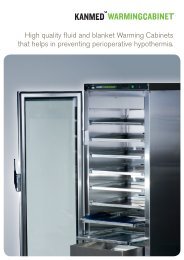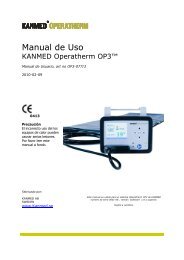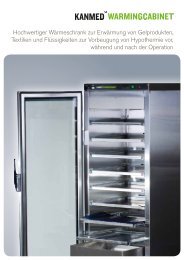User Manual - Kanmed
User Manual - Kanmed
User Manual - Kanmed
You also want an ePaper? Increase the reach of your titles
YUMPU automatically turns print PDFs into web optimized ePapers that Google loves.
High priority alarms<br />
Page 20 of 28<br />
<strong>User</strong> <strong>Manual</strong> BW3-070/2<br />
If a high priority error is detected, the heating is switched off and the alarm is activated (the error code is<br />
displayed, audio signal emitted and the red LED flashing). After pressing the Alarm button, the unit goes to<br />
stand by. If a restart is performed, please carefully observe that a correct self test is being performed.<br />
Code Description Action<br />
01<br />
02<br />
03<br />
04<br />
05<br />
06<br />
07<br />
08<br />
09<br />
10<br />
11<br />
12<br />
13<br />
14<br />
Power loss has occurred during normal operation. The power alarm can be silenced by the operator by pressing the<br />
alarm button for about 2 seconds. When power is restored, reset the<br />
alarm and restart the unit .<br />
High H2O temp alarm: The calculated H2O-<br />
Mattress temperature (thermistor T1 or T3) has<br />
exceeded 41°C for more than 30 sec.<br />
Measuring error: The independent Hard Ware<br />
based safety circuit has detected that the H2O<br />
thermistor T3 render a higher reading than 42°C or<br />
the element thermistor T4 more than 43°C, or the<br />
internal reference deviates more than 1 %.<br />
High GEL temp alarm: The calculated Gel<br />
Mattress temperature (thermistor T2 or T4) has<br />
exceeded 45°C (peak reading).<br />
Sensor error A: Thermistor T1 or T2, or the<br />
measuring circuit is faulty (open loop).<br />
Sensor error B: Thermistor T3 or T4, or the<br />
measuring circuit is faulty (open loop).<br />
Sensor error C: Thermistor T1, T2, T3 or T4, or<br />
the measuring circuit is faulty (rendering a value<br />
grater than 49°C).<br />
Regulator error: The heating Pad output has been<br />
active (or inactive) for more than 120 consecutive<br />
sec, indicating an error in the output circuit.<br />
High internal temperature: The Control Unit's<br />
internal temperature has exceeded 60°C.<br />
Safety relay malfunction: The safety relay does<br />
not operate properly.<br />
Too high current in the Heating Pad: Internal<br />
short circuit detected in the PAD.<br />
Uneven Heating Pad temp in H2O mode: Unnatural<br />
temperature differences (> 1,4° C )<br />
measured between the two H2O thermistors T1 and<br />
T3.<br />
DC power error. The Heating Pad voltage is either<br />
lower than 9 V, or higher than 28 V.<br />
Uneven Heating Pad temp in GEL mode: Unnatural<br />
temperature differences measured between<br />
the two H2O thermistors T1 and T2, OR between T3<br />
and T4. During the first two hours after a cold start,<br />
the maximum allowed temperature difference is 8°<br />
C, thereafter 4° C.<br />
Reset the alarm. Check the actual Water Mattress temperature. If<br />
there is a logical explanation (e.g. a external heat source affecting the<br />
Heating Pad), then make necessary corrections. Restart the unit.<br />
Check that the self test performs OK. If the alarm re-occurs, the<br />
system should be analyzed and/or replaced.<br />
Reset the alarm. Check the actual Water Mattress temperature. If<br />
there is a logical explanation (e.g. an external heat source affecting<br />
the Heating Pad), then make necessary corrections. Restart the unit.<br />
Check that the self test performs OK. If the alarm re-occurs, the<br />
system should be analyzed and/or replaced.<br />
Reset the alarm. Check the actual mattress temperature. If there is a<br />
logical explanation (e.g. an external heat source affecting the heating<br />
pad), then make necessary corrections. Restart the unit. Check that<br />
the self test performs OK. If the alarm re-occurs, the system should be<br />
analyzed and/or replaced.<br />
Reset the alarm. Replace the Heating Pad. Restart the system. Check<br />
that the self test performs OK. If the alarm re-occurs, the system<br />
should be analyzed and/or replaced.<br />
Reset the alarm. Replace the Heating Pad. Restart the system. Check<br />
that the self test performs OK. If the alarm re-occurs, the system<br />
should be analyzed and/or replaced.<br />
Reset the alarm. Replace the Heating Pad. Restart the system. Check<br />
that the self test performs OK. If the alarm re-occurs, the system<br />
should be analyzed and/or replaced.<br />
The Control Unit should be replaced and the faulty unit analyzed by an<br />
authorized technician.<br />
Reset the alarm. If there is a logical explanation (e.g. an external heat<br />
source affecting the Control Unit), then make necessary corrections.<br />
Restart the unit. Check that the self test performs OK. If the alarm reoccurs,<br />
the system should be analyzed and/or replaced.<br />
The Control Unit must be replaced and the faulty unit analyzed by an<br />
authorized technician.<br />
The Control Unit and the Heating Pad must be replaced and the faulty<br />
system analyzed by an authorized technician.<br />
Reset the alarm. If there is a logical explanation (e.g. a heavily tilted<br />
bed during warming up phase, low water level in the Water Mattress,<br />
external heat source or high thermal load affecting one of the<br />
thermistors), then make necessary corrections. Restart the unit. Check<br />
that the self test performs OK. If the alarm re-occurs, the system<br />
should be analyzed and/or replaced.<br />
If the control unit is fed by external DC batteries, check the external<br />
supply voltage and the adapter. If the unit is fed by mains AC Power<br />
and this alarm occurs, the control unit should be analyzed and/or<br />
replaced.<br />
Reset the alarm. If there is a logical explanation (e.g. a Gel Mattress<br />
without aluminium plate is used, external heat source or high thermal<br />
load affecting the Heating Pad), then make necessary corrections.<br />
Restart the unit. Check that the self test performs OK. If the alarm reoccurs,<br />
the system should be analyzed and/or replaced.


